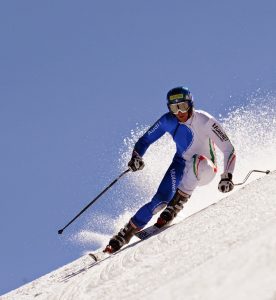
Remember the last time you spent a Saturday outside in the snow? If you’re in Southern California, you may have to think pretty hard, but for most SaltStick users, December through February brings snow and colder temperatures. What does this mean for hydration? Do you still need electrolytes? Should you put your SaltStick capsules on the shelf — untouched until springtime?
In short, absolutely not! We blogged last year about the effect colder temperatures have on hydration levels. You can read the full post here, but essentially, you’re still susceptible to dehydration during the winter months. Think again about your Saturday in the snow. You probably felt pretty good, even though you were outside for several hours … at least until you returned indoors. Then, the effects of dehydration (thirst, low energy levels) hit full-force. Why the sudden change? Essentially, when you’re cold, you’re less likely to feel thirsty when you lose fluids because your body keeps the blood close to your internal organs. Once you warm up, your brain can process the state of your extremities, and you realize you’re quite dehydrated.
Endurance Athletes:
As any endurance athlete knows, dehydration is the enemy of performance. Thirst is a good indicator for low fluid levels in warm temperatures, but you can’t rely on thirst alone when it’s cold outside. You still need to drink water and replenish electrolytes — even if you don’t feel thirsty — and the suggested intake of 1-2 SaltStick Caps per hour remains appropriate, though as always, usage depends on your unique physiology, training, and conditions.
Another option is to take your workouts indoors. The pleasant 70-degree temperatures will remove the risk of ignoring dehydration, and 1-2 SaltStick Caps per hour, along with fluid, will keep your electrolyte levels at a stable level.
Winter Life:
We realize not everyone will spend the winter months in base training for an Ironman triathlon. However, you can still use SaltStick! Here are a few examples when the electrolyte boost SaltStick Caps provide can help out:
- Shoveling snow: The downside to every snowstorm is the hours spent clearing your driveway after the precipitation ends. On the bright side, though, it’s a great workout! FitDay estimates that a 150-pound man will burn 350 calories per hour shoveling snow. A 130-pound woman will burn 284. Ensure you don’t deplete yourself by popping a SaltStick Cap.
- Winter sports: Skiing, snowshoeing, snowboarding and ice skating all have the potential to be high-intensity workouts (which makes them great cross-training exercises for endurance athletes). This brings along the potential for dehydration, especially if you’re outdoors for several hours. Bring along some water and consume 1-2 SaltStick Caps per hour (starting to see a theme here?), and you’ll ensure you can have fun and keep going all day long.
- Family fun: Believe it or not, simply getting outdoors can burn several hundred calories per hour. The Huffington Post estimates that a 150-pound male will burn upwards of 520 calories per hour in a snowball fight and 400 per hour while sledding. As with any form of exercise, this high-intensity work has the potential to dehydrate you. Before heading out the door, pop 1-2 SaltStick Caps, with fluid, and you’ll be able to enjoy the snow without the risk of dehydration.
- Celebrations: Blogger Crista Scott highlights a final – and less official – usage of SaltStick. After the Après ski and New Year’s celebrations, SaltStick can make a great hangover cure.
As you can see, SaltStick can be an effective tool to prevent dehydration in the winter months. Don’t let a lack of thirst fool you into thinking that you’re not losing fluids and electrolytes when it’s cold outside. Be safe, stay hydrated, and have fun!